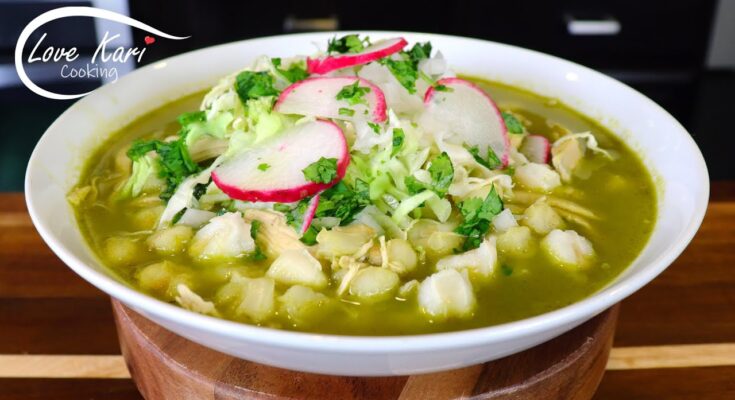Green Pozole Recipe: If you’re in the mood for a comforting, soul-warming dish that’s packed with flavor and tradition, then green pozole is your go-to recipe. This vibrant Mexican soup combines tender meat, hearty hominy, and a spicy green sauce made with tomatillos and chiles, resulting in a dish that’s not just delicious, but also rich in culture and history. Ready to get your hands into something seriously tasty? Let’s dive into the ultimate step-by-step guide for making authentic green pozole at home.
What is Green Pozole?
Green pozole, or pozole verde, is a traditional Mexican soup or stew known for its zesty and herbaceous green broth. Unlike its red counterpart (pozole rojo), which uses red chiles, green pozole is made with tomatillos, green chiles, and fresh herbs like cilantro and epazote. The result? A dish that is tangy, fresh, and just the right kind of spicy.
Typically, green pozole is made with pork or chicken and features hominy—large, puffy kernels of corn that have been soaked in an alkaline solution. These chewy, nutty kernels soak up the flavors of the broth, making every spoonful deeply satisfying.
History and Cultural Significance
Pozole has deep roots in Mexican culture. It dates back to pre-Columbian times, when it was used in ceremonial contexts by indigenous people. Originally, it was a sacred dish, served during rituals and community gatherings. As the Spanish colonized Mexico and culinary practices evolved, the recipe adapted, incorporating ingredients like pork and modern cooking techniques.
Today, green pozole is often served during celebrations, holidays, and special occasions. In states like Guerrero and Oaxaca, it’s a staple at parties and a symbol of hospitality and home-style cooking.
Key Ingredients You’ll Need
Meat Choices – Traditional vs Alternatives
The base of green pozole traditionally includes pork shoulder, known for its tenderness and flavor when simmered. However, chicken is a popular alternative, especially for those looking for a lighter or leaner version.
- Traditional Choice: Pork shoulder or pork ribs.
- Alternative Options: Boneless chicken thighs or breasts, turkey, or even a vegetarian protein like jackfruit or mushrooms.
No matter your choice, the goal is to cook the meat until it’s fall-apart tender, infusing the broth with rich, meaty depth.
Hominy – The Heart of Pozole
Hominy is more than just an ingredient—it’s the soul of pozole. Made from dried maize kernels treated with an alkali in a process called nixtamalization, hominy becomes softer, puffier, and more digestible.
- Canned Hominy: Convenient and ready to use, simply rinse and add to the soup.
- Dried Hominy: Needs to be soaked overnight and simmered for several hours, but delivers a more authentic texture.
Pro tip: If you can find cacahuazintle (Mexican heirloom hominy), use it for the most traditional experience.
Green Sauce Ingredients
The vibrant green sauce is what sets this pozole apart. It’s made by blending roasted tomatillos, green chiles (like jalapeños or serranos), and plenty of herbs.
- Tomatillos: Tangy and bright, these are the base of the green sauce.
- Green Chiles: Jalapeños, serranos, or even poblano peppers can be used depending on your heat preference.
- Fresh Herbs: Cilantro, parsley, epazote, and sometimes spinach for added color and nutrition.
- Garlic and Onion: Add depth and umami to the sauce.
Roasting the tomatillos and chiles before blending adds a subtle smoky flavor that elevates the entire dish.
Kitchen Tools and Equipment
Must-Have Tools for Efficiency
Making pozole from scratch doesn’t require fancy equipment, but a few tools will make your life easier:
- Large Stockpot: You’ll need something big enough to hold all your broth, meat, and hominy.
- Blender: To puree the green sauce to silky smooth perfection.
- Strainer or Sieve: For straining the green sauce to get rid of any tough skins or seeds.
- Sharp Knife and Cutting Board: Essential for prepping meat and veggies.
Optional Tools That Make It Easier
- Pressure Cooker or Instant Pot: Speeds up cooking the hominy or meat.
- Food Processor: Can be used to chop large quantities of herbs or veggies fast.
- Immersion Blender: For blending the green sauce directly in the pot without transferring it.
With these tools on hand, you’re ready to tackle this dish like a seasoned home chef.
Preparation Before Cooking
Soaking and Preparing Hominy
If you’re using dried hominy, this is your first step and it starts the night before.
- Rinse the hominy well to remove dust and debris.
- Soak in a large bowl with water covering at least 2 inches above the kernels.
- The next day, drain and rinse again before cooking.
Simmering dried hominy can take 2-3 hours, so starting early is key. For canned hominy, just rinse under cold water and set aside until ready to add.
Prepping the Meat
Cut your meat into medium-sized chunks, especially if using pork shoulder. Season lightly with salt and optionally, sear in a hot pan to lock in juices and flavor before boiling. This step adds a slight caramelized edge to the meat.
For chicken, skinless bone-in thighs give the richest flavor, though boneless pieces are fine for a faster version.
Making the Green Sauce
Roast your tomatillos, chiles, garlic, and onions until charred and softened. Let them cool slightly, then blend with herbs and a bit of chicken stock until smooth. Strain if needed. This sauce is the flavor bomb that transforms your broth into a masterpiece.
Cooking Green Pozole Step-by-Step
Step 1 – Cooking the Meat
Start by adding your prepared pork or chicken into a large stockpot. Cover it with water, about 12 cups, depending on the quantity of meat and desired soup volume. Add aromatics like onion halves, a few garlic cloves, bay leaves, and a bit of salt. Bring the pot to a boil, then reduce the heat to medium-low and simmer.
Let it cook gently for 1.5 to 2 hours, skimming off any foam or impurities that rise to the top. This helps keep your broth clear and flavorful. If you’re using chicken, it’ll cook faster—usually in about 45 minutes to 1 hour.
As the meat cooks, it tenderizes and releases juices, forming the foundation of a rich broth. If you used bone-in meat, be sure to remove the bones before continuing. Once done, remove the meat from the pot, shred it with forks, and set it aside. Reserve the broth—it’s liquid gold!
Step 2 – Adding Hominy
Once your meat is tender and out of the pot, it’s time for the hominy to take a dip. Whether you’re using pre-cooked canned hominy or dried and simmered hominy, drain and rinse it well before adding it to the broth.
Add the hominy directly to the pot of broth. Let it cook for about 30–40 minutes on medium heat so it absorbs the savory flavors of the broth. This simmering stage lets the hominy release a little starch, thickening the soup slightly and melding with the upcoming green sauce.
Don’t forget to stir occasionally. The starch from the hominy can settle at the bottom, and you want a uniform texture throughout the soup.
Step 3 – Mixing in the Green Sauce
Now comes the magic moment: adding the green sauce. Slowly pour your blended and strained green sauce into the simmering pot with the hominy. Stir it in thoroughly and watch as your broth transforms from a clear soup into a vibrant, herbaceous, emerald-green pozole.
Simmer the mixture gently for another 20–30 minutes, allowing the tomatillos and herbs to infuse the entire dish with their tangy, grassy flavor. At this stage, taste the soup and adjust the seasoning—add more salt if needed, or a pinch of Mexican oregano for depth.
This is also the perfect time to toss the shredded meat back into the pot. Let it heat through and soak up all those beautiful green flavors.
Step 4 – Simmering and Flavoring
With all components united in one pot, let the pozole gently simmer for at least 20 more minutes. This helps the flavors marry beautifully and creates that classic pozole consistency—slightly thick, hearty, and soul-satisfying.
Some cooks add a spoonful of lard or a splash of oil at this stage to enhance the mouthfeel and give the soup a silky texture. You can also throw in a few epazote leaves or a dash of cumin for added layers of flavor.
Before serving, give the pozole a final stir and taste. It should be zesty, savory, and just the right amount of spicy. If the soup is too thick, you can always add a bit more broth or water to thin it to your liking.
Serving Green Pozole
Toppings and Garnishes That Elevate the Dish
One of the best things about green pozole is how customizable it is. Once the base soup is ready, it’s time to have fun with toppings. This is where the dish truly comes to life—think of it as a taco bar, but for soup. Everyone can dress their bowl to their own liking, making each serving unique and bursting with flavor.
Here are some must-have garnishes that add texture, freshness, and a pop of color:
- Shredded Cabbage or Lettuce: Adds crunch and freshness.
- Radishes: Thinly sliced, they give a peppery bite and vibrant color.
- Avocado: Sliced or cubed for creaminess.
- Onion: Diced white or red onion gives sharpness.
- Lime Wedges: A squeeze of lime brightens everything up.
- Oregano: Crumbled Mexican oregano for a fragrant finish.
- Chiles: Sliced jalapeños or crushed chile piquín for extra heat.
- Tostadas or Tortilla Chips: Perfect for dipping or crumbling over the top.
Encourage guests or family members to create their own bowls. It’s part of the fun and tradition!
What to Serve With Green Pozole
Pozole is hearty enough to stand on its own, but if you’re feeding a crowd or want to round out the meal, here are a few delicious side options:
- Tostadas: Crisp, flat tortillas often served alongside pozole.
- Refried Beans: Creamy beans are a classic and filling complement.
- Mexican Rice: Adds another layer of flavor and can soak up the soup.
- Cerveza or Agua Fresca: Pair it with a cold Mexican beer or a refreshing drink like hibiscus tea or horchata.
Pozole verde is not just a dish—it’s a celebration on the table. Whether it’s a family gathering, weekend dinner, or holiday feast, this dish makes everyone feel warm and welcome.
Storing and Reheating Pozole
How to Store Leftovers Properly
One of the best things about pozole? It gets even better the next day. Like many soups and stews, the flavors deepen and meld beautifully overnight. So don’t be afraid to make a big batch!
Here’s how to store it safely:
- Refrigerator: Let the pozole cool to room temperature, then transfer to an airtight container. It will last in the fridge for up to 4-5 days.
- Freezer: Pozole freezes like a dream. Store in freezer-safe containers or heavy-duty bags. Be sure to leave some space at the top as the soup will expand when frozen. It can last up to 3 months.
If you’re planning to freeze it, you might consider storing the hominy separately, as it can absorb too much liquid and get mushy.
Best Ways to Reheat Pozole
To reheat, pour your desired amount into a pot and warm it gently over medium heat until hot. Stir occasionally to ensure even heating. If the soup has thickened too much in the fridge, just add a little water or broth to loosen it.
Avoid using high heat as it can break down the meat and hominy too quickly, altering the texture. And always taste after reheating—you might need to refresh it with a pinch of salt or squeeze of lime.
Tips and Tricks for the Best Pozole Verde
Secrets from Mexican Kitchens
Want to take your pozole from good to legendary? Here are some tried-and-true tips from home cooks across Mexico:
- Roast, Don’t Boil: Roasting tomatillos, garlic, and chiles brings out a richer, more complex flavor than simply boiling them.
- Fresh Herbs Are Key: Use fresh cilantro, parsley, and epazote. Dried herbs can’t deliver the same vibrant green hue or fresh taste.
- Sear the Meat First: Browning pork or chicken before boiling it enhances the meat’s flavor and gives the broth a deeper, more robust taste.
- Don’t Skip the Strain: Straining the green sauce after blending removes fibrous skins and seeds, giving your broth a smooth, restaurant-quality finish.
- Let It Rest: Pozole tastes even better the next day. If you can, make it a day ahead and reheat gently before serving.
Common Mistakes to Avoid
Even seasoned cooks can slip up. Avoid these common pozole pitfalls:
- Overcooking the Hominy: If you’re using canned hominy, it’s already cooked. Over-boiling it will turn it mushy.
- Under-seasoning: Pozole needs a generous hand with salt and seasonings to bring out its full flavor. Always taste and adjust!
- Skipping the Garnishes: Toppings aren’t optional—they’re essential! They add texture, color, and balance to the richness of the soup.
Following these tips will ensure your green pozole is a showstopper every time.
Health Benefits of Pozole Verde
Nutritious and Delicious
Beyond its bold flavor, green pozole also packs a healthy punch. Here’s what makes it a smart choice for a wholesome meal:
- Protein-Rich: Whether you use pork or chicken, pozole is loaded with lean protein that keeps you full and satisfied.
- High in Fiber: Hominy offers a good dose of dietary fiber, which aids in digestion and keeps blood sugar levels stable.
- Vitamin Boost: Tomatillos and green chiles are rich in vitamin C, antioxidants, and essential minerals.
- Low in Fat: When made with skinless chicken or lean pork, green pozole is naturally low in saturated fat.
- Gluten-Free: Naturally free from gluten, pozole is a great choice for those with dietary restrictions.
Pair it with fresh veggies and healthy toppings like avocado and cabbage, and you’ve got a nutrient-dense, balanced meal that’s as good for your body as it is for your soul.
FAQs about Green Pozole Recipe
What is green pozole made of?
Green pozole (pozole verde) is a traditional Mexican soup made with hominy (nixtamalized corn), shredded chicken or pork, and a vibrant green sauce made from tomatillos, green chilies, garlic, onion, and fresh herbs like cilantro and epazote.
Is green pozole spicy?
It can be! The spiciness of green pozole depends on the type and amount of green chilies used. You can adjust the heat by using milder peppers or deseeding them before blending.
Can I make green pozole vegetarian or vegan?
Absolutely. Substitute the meat with hearty vegetables like mushrooms or zucchini, and use vegetable broth instead of chicken or pork stock for a delicious plant-based version.
What toppings go on green pozole?
Popular toppings include shredded lettuce, chopped onions, radishes, avocado slices, lime wedges, oregano, and crunchy tostadas or tortilla chips.
How long does green pozole last in the fridge?
Green pozole keeps well in an airtight container in the refrigerator for up to 4–5 days. It often tastes even better the next day as the flavors develop.
Can I freeze green pozole?
Yes, green pozole freezes well for up to 2–3 months. Store it in freezer-safe containers without toppings, and thaw overnight in the fridge before reheating.
What is the difference between green and red pozole?
The main difference lies in the sauce. Green pozole uses tomatillos and green chilies, while red pozole is made with dried red chilies like guajillo or ancho for a deeper, smokier flavor.
Conclusion
Green pozole isn’t just a recipe—it’s an experience. With roots deep in Mexican tradition and a flavor profile that’s both comforting and invigorating, this dish has earned its place at family tables and festive gatherings alike. From the tender meat to the chewy hominy and the vibrant, tangy green sauce, every spoonful is a celebration of culture, flavor, and love.
Whether you’re making it for the first time or the hundredth, this guide ensures you’ll nail it every time. So roll up your sleeves, grab your stockpot, and start cooking. Your kitchen is about to smell amazing.



